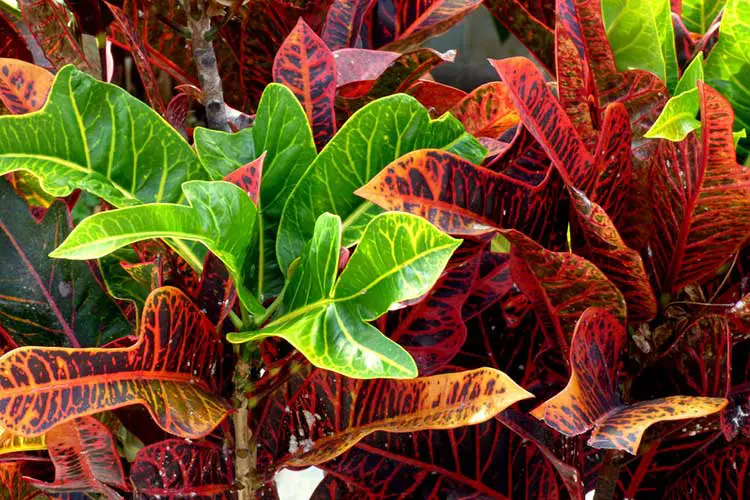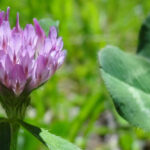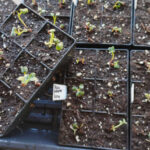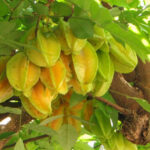Crotons offer a splash of color to any environment. With thick, leathery leaves that have a shiny surface and grow in a wide variety of colors, they’re admired as an ornamental. Croton plants flower, with both male and female flowers on a given plant — but their inflorescence pales in comparison to the red, orange, yellow, black, even green or bluish-purple hues that the leaves produce.
While there is an entire genus called Croton, today we’re focusing on C. variegatum. The garden Croton or variegated Croton is a stunning houseplant that is widely popular, and there are many Croton cultivars. Let’s go over everything there is to know about this particular Croton species – including propagating croton plants – and get you started!
Listen to this post on the Epic Gardening Podcast
Subscribe to the Epic Gardening Podcast on iTunes
Croton Overview

| Common Name(s) | Croton |
| Scientific Name | Codiaeum variegatum |
| Family | Euphorbiaceae |
| Height and Spread | Up to 10 feet |
| Light | Direct sunlight, filter harsh light and full sun |
| Water | Average |
| Soil | Rich soil, fast draining |
| Pests and Diseases | Mealy bugs, caterpillars, spider mites, scale insects, Oedema, root rot, Anthracnose, powdery mildew, crown gall |
Types of Croton Plants
There are hundreds of varieties of Crotons. Today we’ll highlight a few of my favorites. If none appeal to you, don’t stop looking. There’s many a Croton variety out there with colorful foliage. There are tons of leaf shapes too!
C. variegatum ‘Gold Dust’
This particular Croton has vibrantly green leaves that look as though someone splashed golden-yellow paint all over them. In frost-free areas, it’s common as a landscaping shrub, but it can be grown indoors as well. Its leaves are rounded ovals with almost a waxed surface shine. There is another similar cultivar, called Gold Star. The only difference between the two is Gold Star has narrower leaves.
C. variegatum ‘Mammy’
The Mammy varietal is stunning, as its twisted, multi-hued leaves look like long streamers erupting out of its container. Grown indoors, its leaves are more subtle in coloration, tending towards greens and purples with bits of red, but if grown in bright light environments it rapidly transforms into an explosion of brilliant color.
C. variegatum ‘Petra’

One of the most common Croton varieties available, Petra’s leaves are green with bold yellow, red, or orange veining and edging. It gives the pointed-oval leaves a lacy appearance when viewed from a slight distance.
C. variegatum ‘Mother and Daughter’
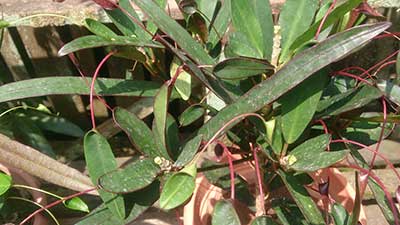
This unique Croton plant has interesting dual narrow leaves. Long and slender, they come to a rounded tip from which the central leaf vein extends, with a secondary leaf attached to it. They grow in variegated shades of green to purple, and are really interesting plants to keep!
C. variegatum ‘Red Iceton’
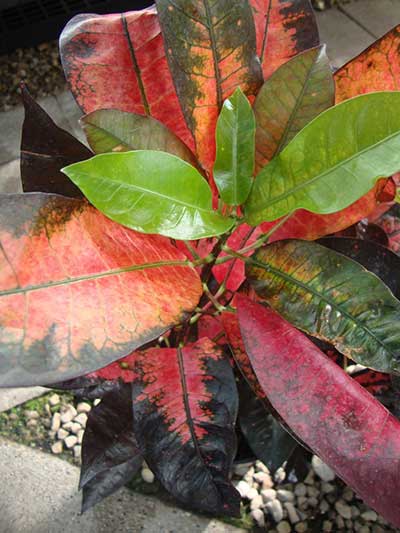
Red Iceton is one of the more striking Croton varieties. Its pointed-tipped oval leaves go through a color change – when new, the leaf color is a bright, warm yellow. As the leaves age, they shade into red and pink hues.
C. variegatum ‘Magnificent’
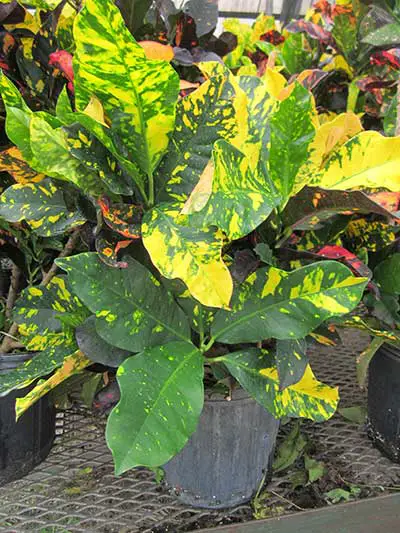
The Magnificent Croton is similar to the Gold Dust Croton in leaf shape and dappled patterning, but that’s where the similarities end. This variety has brilliant shades of red, orange, pink and yellow spattered across the leaves. Occasionally there will be bits of bronze or a purplish hue as well. It’s magnificent, just as its name implies.
C. variegatum ‘Oakleaf’
This interesting Croton variety gets its name from the shape of its leaves, which resemble the multi-fingered oak leaf shape. It tends to green leaves to bronzes with red, orange, and yellow veining.
C. variegatum ‘Eleanor Roosevelt’
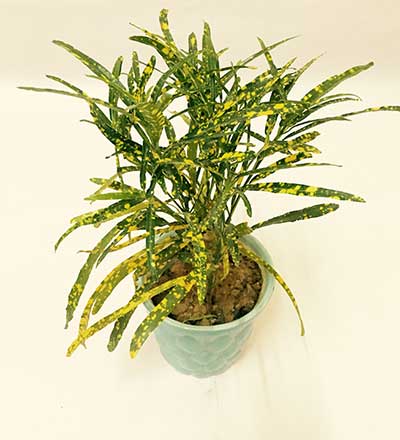
A stunning change from other plants that are Croton varieties, the Eleanor Roosevelt has long, slender leaves. The base hue of the leaves is a nice medium green, but they shift to a deep purple, and all of the leaves are dotted with a bright yellow spotted pattern. This unique variation provides a shift from the broader leaves of other plants.
C. variegatum ‘Zanzibar’
For those who like ornamental grass, there’s a Croton plant for you! The Zanzibar Croton plant has such slender leaves that they resemble blades of grass, and they are dolloped in shades of purple, orange, gold and even red. These Croton plants make a beautiful contrast to their broad-leaved siblings and still share the bright colorways of their species.
Croton Plant Care Guide
Croton plants have a reputation for being fussy, but that’s related to the fact that they don’t like being moved much. Once your plant has gotten over its initial shock (and possibly leaf loss) from being moved around, following these guidelines will give you the best-looking Croton plant foliage.
Tropical Light and Temperature
Grow Croton plants in bright light, a requirement for them to produce those stunning multicolored leaves. But they also don’t like to be burned by the full sun, as they typically live on the floors of the tropical forests of Southeast Asia. If you are in a very hot or dry environment where the sun is oppressive, put some shade cloth around your plants so that they can absorb less of the direct UV rays during the heat of the day.
If you’re growing a Croton plant indoors, give them enough light with brighter spots near windows or under grow lights. They can be grown outdoors, but keep them indoors when warm temperatures exceed 80° Fahrenheit, or when temperatures drop below 55°.
Water and Humidity
Like most tropical plants, Croton plants like humidity. In your Croton plant care practice, set your Croton plant on top of a rock tray with a little water in it to help keep the moisture up around the plant. If you’re raising yours as a hanging plant, occasional misting increases the ambient humidity.
Croton plants like moist soil but also don’t like to have wet feet, so only water them when the top half-inch to an inch of soil is dry to the touch. When you water them, water until it starts to come out of the bottom of the container, then wait until the soil dries out again before rewatering.
Croton plants can be susceptible to over-watering. If you find that your Croton’s leaves are wilting, that may be a sign of too much water, or too much soil moisture. If the lower leaves are drying out or falling off, that’s a sign of under-watering and your Croton plant’s thirsty. Maintain consistently moist soil.
Soil for Crotons
Croton plants prefer a well-draining soil with lots of organic material. Most good potting soils are fine, and an ideal range for the soil pH level is between 4.5-6.5 pH. High pH rock soils are not advisable, as are soils that are very calcium-rich. Most likely the potting soil found at your nearby big box store is sufficient.
Fertilizer for Crotons
A popular fertilizer type for Croton plant care is an 8-2-10 mix, as they like a lot of potassium. Most often, they’re fed once durin the growing season in the early spring (Feb-March), and then again in the late spring (May), giving them a good slow-release acidic fertilizer that will feed them throughout the early summer months. Younger Croton plants may require a third feeding somewhere in mid-July. Don’t fertilize outside the growing season in the fall, as the leaves need to mature and harden off before winter.
Propagation of Croton Plants
There are several ways to propagate Croton plants.
Crotons are most commonly propagated via stem cuttings from a parent plant. Trim a segment from your Croton plant that has at least three sets of leaves using a sharp, clean pair of shears. Strip off all but 3-5 leaves from the top of the stem. Place this directly into a glass of water, or dip it into a rooting hormone and place it into a mix of vermiculite, river sand, and peat moss.
Place a cover over the Croton plant to help keep it humid as it develops roots. If you don’t have a glass cloche or other humidity-trapping cover, use a plastic bag to simulate one. Once new growth roots have formed, transplant your Croton plant gently into a good, well-draining potting mix.
Some people have found it possible to separate Croton plants at the root, especially if they have outgrown their container and you see roots growing through the drainage hole. However, this can be problematic, as the Croton plant doesn’t like being moved around much, and both your original plant and new stem cuttings may suffer wilting and leaf-loss this way.
Finally, there’s a process called air layering. Make a diagonal cut through one third to half of the diameter of a Croton plant stem while it’s still attached to the main plant. Treat the resulting wound with some rooting hormone, and keep it open with a wooden matchstick or toothpick.
Then, carefully pack damp sphagnum moss around the area, and wrap it in plastic wrap. Make sure it’s kept moist – if the moss begins to turn tan in color, it needs to be remoistened. The wound will form new growth roots in time. Once those roots have developed, unwrap the plastic wrap, trim the rest of the way through the stem, and repot your new plant in a well-draining potting mix.
Repotting Crotons
As your Croton plant grows, it will eventually get to the point where it needs a larger pot. Repotting is an important part of Croton plant care. Select a pot that’s only 1-2 inches larger in diameter than its current one, and take some of your potting mix and place some in the bottom of the new pot. Then, carefully and gently remove your Croton plant from its old pot.
If it appears to be a bit root-bound, separate the roots slightly with your fingers. If they’re too interlocked, use a potting knife to score the roots lightly. Then place the Croton plant into the pot, making sure there’s enough potting soil below to put it within an inch of the pot’s top. Carefully fill around the sides of the plant with additional potting soil as needed, and then water it thoroughly to moisten all of the soil and help it settle, stopping when water comes out the bottom of the pot.
Pruning Crotons
Generally, Croton plants only need to be pruned to remove dead or unhealthy foliage or to maintain a compact size. If you need to prune your Croton plant, wear gloves, as the Croton’s milky sap can cause skin irritation. Use a sharp, clean pair of bypass loppers or shears to make your cuts.
Dead Croton leaves and branches should be pruned all the way to the main body of the Croton plant. Diseased branches should be cut off at least six inches outside of the diseased area, ideally just above a leaf or node on the stem. Long or overgrown branches should also be cut back just above a leaf or node on the stem to maintain the plant’s shape.
Unless the branches are dead or diseased, avoid cutting more than a third of a branch’s length off so you don’t stress the Croton plant. Allow it to form new leaf growth before pruning it again.
Troubleshooting Crotons
Now that we’ve discussed Croton plant care, let’s talk about problems. Here’s what might be causing issues and how to fix them.
Croton Growing Problems
Probably the most common growing problem that people may experience is their Croton plant staying green. If you have something like a Mammy or a Magnificent, or any other plants that are supposed to have brightly colored leaves, with red orange and yellow leaves, and yet they’re all dark green, this is usually a sign of incorrect or insufficient light.
While Crotons don’t mind partial shade (and a few croton plant varieties prefer it), a lack of color generally means it’s not getting enough light to produce those bright tones. Croton plants prefer bright light and cool temperatures in the 60-80 degree range. If you can provide that environment, you should have stunning colors regularly.
If the plant faces directly into the summer sun, you may notice greyish patches on Croton leaves. This generally means that the leaves are fading due to too much heat with their light. Adding some shade cloth or repositioning your Croton plants to a location which is naturally shadier during the hottest parts of the day will help.
While some croton plant varieties such as Mammy naturally twist, if your Croton plant is not one of those, finding twisted leaves on it is a sign of over-fertilization. This is most common during the summer months when your plant shouldn’t be fertilized. Stick with a couple feedings in the spring (one early, one late), and refrain from feeding throughout the rest of the year.
I mentioned earlier that Croton plants don’t like to be moved around, and this is very true — they can lose leaves just from being brought home from the store. As long as you are not regularly carrying your plant in and out of the house, or moving it regularly if it’s planted outdoors, this should not be an issue.
Pests of Crotons
Croton houseplants are typically most susceptible to spider mites. They cause the leaves of your plant to become speckled with yellow and may stunt leaf growth (which can be hard to see in some Croton varieties!), and eventually cause leaf drop. These little pests can be removed by gently cleaning off the leaves of your Croton plant with a moistened towel. Keeping the humidity up can help prevent them.
Outdoors, there are a few more pests that are common. One of these is the Croton scale, which is a strange little insect that is hard to identify as it makes itself look like it’s just part of the plant. This video shows some examples of Croton scales when they’re infesting a Croton plant. Treatment with neem oil or another horticultural oil every 5-7 days for 3-4 treatments is effective for removing these, but if your plant is in dire straits, use a soft toothbrush to brush off the scales.
Mealybugs on your plants can become an issue, and sometimes cause leaf drop. Remove smaller colonies by dabbing them with a cotton swab dipped in rubbing alcohol. Spray larger colonies off using a heavy spray of water, or kill them with neem oil or insecticidal soap.
Petra Crotons are particularly susceptible to leaf-burrowing thrips. To control thrips, hose them down thoroughly in the morning with cold water while they’re are still resting. Do this multiple days for full effect. Set a little of your early morning time aside to wash your petras for up to a week. If they persist, insecticidal soap or neem oil is recommended.
Finally, there is the Croton caterpillar, Achaea janata. These eat the leaves of Croton plants, leaving behind only the stems and veins. Regular applications of neem oil are effective at reducing leaf consumption, but if the caterpillars persist, BT (Bacillus thuringiensis) can be sprayed onto the plants as well. This infects the caterpillars and kills them, but is harmless to humans, animals, and the plant.
Diseases
There are a few diseases which may strike your Croton plants. Crown gall, leaf spot, oedema, root rot, and white powdery mildew are by and large the most prevalent.
Oedema ooks like blistering on the leaves and is caused when your Croton plant is taking in more water than it can actually handle. Reduce the regularity of watering Croton plants until the blistering subsides, and avoid over-watering. Keep the soil moist, though. Root rot is caused by overwatering too, especially when you’re working with cut stems.
Crown gall is caused by a bacteria (Agrobacterium tumefaciens) that stimulates swollen growths on the stems and leaf-veins of your plant. It impacts many plants, including roses, apple trees, blackberries and raspberries, and even Crotons. Unfortunately, it’s also notoriously hard to combat. You can carefully cut galls off of the stem with a sharp knife, then treat the wound with a pruning sealer.
However, the bacteria comes from the soil, and can live in the soil for up to two years after an infected plant has been removed, so the galls may come back. There are chemical treatments for crown gall available, but they show limited effectiveness on Crotons, so the best course of action is preventative.
Anthracnose, also referred to as leaf-spot or blight, is a fungal issue that develops on many plants including Croton plants. It causes dark or black water-soaked fungal patches on the leaves of the plant. Treatment with neem oil or a copper spray is recommended. You can also combat this problem by releasing a specific bacillus, Bacillus subtilis, via a special spray formula – the bacillus will consume most fungal developments.
Finally, powdery mildew can develop on Croton plants that regularly have moistened leaves. To prevent this, water your plants from the bottom. A regular application of neem oil also prevents and removes the buildup of mildew on the leaves.
Frequently Asked Questions
Q: Are croton plants poisonous?
A: Crotons have built up a natural defense mechanism that is poisonous, but they can still be grown as houseplants or outdoor ornamentals. Do not try to eat them, and prevent children and pets from eating them. Wear gloves when doing work on your Crotons, as the milky sap can be a skin irritant. If your skin does get irritated by Croton sap, put on a 2.5% hydrocortisone cream after thoroughly washing the surface of the skin. If someone does eat the flowers, seeds, or leaves of your Croton plant, get them to the doctor or the vet for assistance as soon as possible.
Q: Are poinsettias a type of croton?
A: While poinsettias are related to Crotons, they aren’t Crotons themselves. However, just like Crotons, they have a milky sap that can cause skin irritation, and they shouldn’t be eaten!
Q: Do Crotons like sun or shade?
A: Croton plants grow best in bright, indirect light. Because it’s a smaller tropical plant, it appreciates partial shade that occurs in tropical climates too. Don’t put the Croton plant in full sun or direct sunlight, though.
Q: Are Crotons indoor or outdoor plants?
A: You can have outdoor Croton plants or keep one as an indoor plant. Remember to care for indoor Croton plant and bring them in when temperatures go outside its 55° to 80° range.
Q: Where do crotons grow best?
A: Most places, a Croton plant is best cultivated indoors. Regardless, plant them in a space with lots of organic matter, consistent moisture, and bright, indirect light.
Q: How often should you water Crotons?
A: Water your Croton plant when the top 1/2 inch of soil is dry.
Q: Are Crotons fast growing?
A: A Croton plant is considered a medium or slow-grower. If you want more of them, it’s very easy to propagate Croton plants.
Q: How long do croton plants live?
A: You’ll have a Croton plant for 2 to 3 years.

